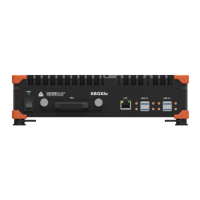SIRIUS
®
TECHNICAL REFERENCE MANUAL
4.3.2. USB hubs vs. native ports
USB, short for Universal Serial Bus, is an industry standard that defines the cables, connectors and
communications protocols.
USB 2.0 has a theoretical maximum bandwidth of 480 Mbit/s (High Speed or High Bandwidth). Due to
bus access constraints, the effective throughput of the High Speed signalling rate is limited to about 30
MB/s.
The SIRIUS slices use the USB 2.0 protocol for communication to the PC/SBOX and they have USB Type
A receptacles. This is enough, even for 8 SIRIUS high-speed channels @ 1MS/s.
USB 3.0 a new SuperSpeed transfer mode, with associated new backwards-compatible plugs,
receptacles, and cables. The SuperSpeed plugs and receptacles have blue inserts (in comparison to the
black ones of USB 2.0). The theoretical maximum data signalling rate of the new SuperSpeed mode is
5.0 Gbit/s. However the specification considers it reasonable to achieve only around 3.2 Gbit/s (0.4 GB/s or
400 MB/s).
A USB hub is a device that expands a single native USB port into several, so that there are more ports
available to connect devices.
If a USB hub is used, the USB bandwidth is shared by the connected USB devices (i.e. SIRIUS® slices)
and thus you may not be able to use the max. possible sampling rate (of the SIRIUS slice). Note, that also
the USB connectors on laptops are often internally connected to a USB hub.
SIRIUS slices should always be connected to the native ports, so that you can use the maximum
sampling rate without USB hub bandwidth limitations
Hint
You only need to care about native ports and hubs when you use external USB ports of the
SBOX. The internal USB connections (e.g. in the SIRIUS RACK Systems), are optimised that
single measurement slice can use the full maximum sampling rate: for all 64 (dual-core,
high-speed) channels or 128 (high-density) channels.
SIRIUS
®
V20-1 42 / 336

